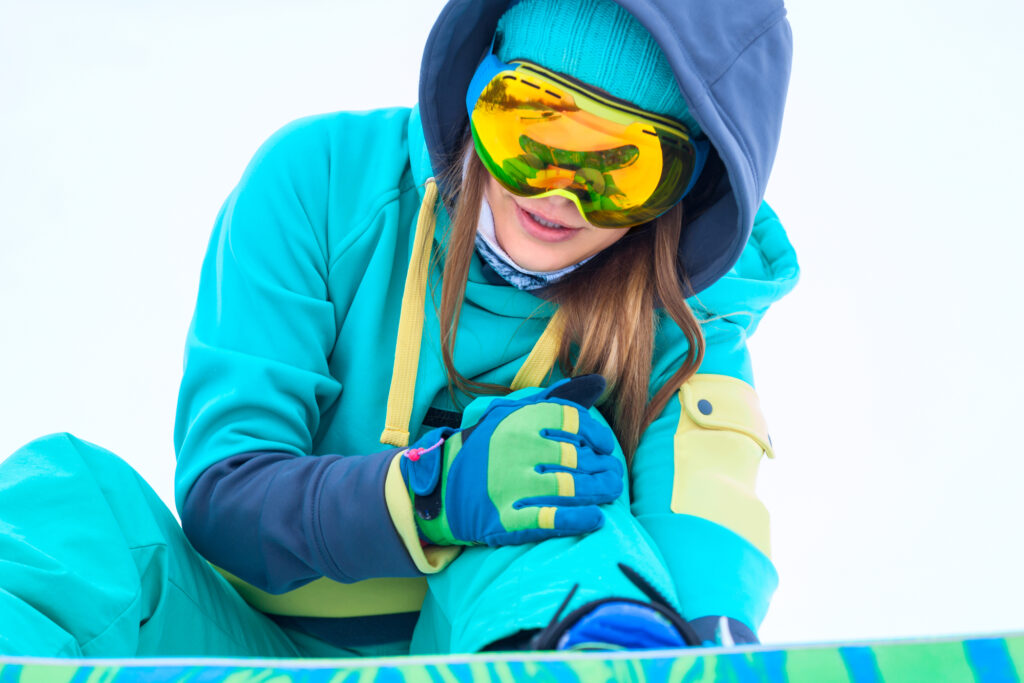Embracing the thrill of snow sports makes the cold winter a little more tolerable and fun for those who live in snowy climates. However, amidst the joy and adventure of snow sports, the inherent risks of injuries loom, reminding enthusiasts of the importance of safety and preparation.
For many injuries that happen from snow sports, they require adequate care and therapy to fully recover. This blog will talk about potential injuries that can happen during winter activities, and what you can do to prevent those injuries.

Common Injuries from Snow Sports
Winter sports often lead to injuries that may necessitate physical therapy for effective rehabilitation. Common injuries requiring physical therapy in the context of winter sports include:
Sprains and Strains: Ligament sprains and muscle strains, prevalent in activities like skiing or snowboarding, often require physical therapy to restore strength, flexibility, and stability.
Fractures and Dislocations: Recovery from fractures or dislocations, commonly occurring in sports like ice skating or snowmobiling, may involve physical therapy to regain mobility and strength after immobilization.
Knee Injuries: Winter sports such as skiing and snowboarding are associated with ACL tears. Physical therapy is crucial for rehabilitation, focusing on strengthening surrounding muscles, improving range of motion, and enhancing stability.
Concussions: Head injuries, including concussions from falls or collisions in high-speed sports like snowboarding, often necessitate a gradual return-to-activity program under the supervision of a physical therapist.
Post-Surgical Rehab: Surgeries for injuries like fractures, ligament reconstructions, or joint repairs may require postoperative physical therapy to ensure optimal healing and functional recovery.
Overuse Injuries: Repetitive motions in winter sports like cross-country skiing or ice skating can lead to overuse injuries such as stress fractures, tendinitis, or muscle strains, often requiring targeted physical therapy interventions.
Hip Injuries: Activities like snowboarding or ice hockey can contribute to hip injuries, and physical therapy is crucial for regaining strength, flexibility, and addressing any imbalances.
Spinal Injuries: High-impact falls in sports like skiing or snowboarding may result in spinal injuries, necessitating physical therapy for rehab and pain management.
Physical therapy plays a crucial role in the recovery process, helping individuals regain strength, flexibility, and function after winter sports-related injuries. A tailored rehab program, overseen by experienced physical therapists, aims to optimize recovery and facilitate a safe return to activity.

6 Ways to Prepare to Prevent Injuries
To mitigate the risk of injuries during winter sports, individuals can take proactive measures before the season starts:
- Conditioning Exercises
Engage in pre-season conditioning exercises that target specific muscle groups used in winter sports. Focus on strength, flexibility, and balance training to enhance overall fitness and reduce risk of injuries.
- Cardiovascular Fitness
Improve cardiovascular fitness through activities like running, cycling, or aerobic exercise. This helps build endurance, crucial for sustained performance during winter sports.
- Sport-Specific Training
Participate in sport-specific training drills to familiarize the body with the movements and demands of the chosen winter sport. This can include agility drills, balance exercises, and skill-specific practice.
- Flexibility Training
Incorporate regular stretching routines to enhance flexibility, reducing the likelihood of strains and sprains. Focus on areas prone to tightness, such as the hamstrings, quadriceps, and hip flexors.
- Proper Gear Inspection
Check and ensure that all winter sports equipment, including skis, snowboards, helmets, and bindings, is in good condition. Replace any worn-out or damaged gear to minimize the risk of equipment-related accidents.
- Balance and Proprioception Training
Enhance balance and proprioception through specific exercises. This type of training helps individuals maintain stability and react effectively to uneven or slippery surfaces encountered in winter sports.
By taking these proactive steps, individuals can significantly reduce the likelihood of injuries and ensure a safer and more enjoyable experience when participating in winter sports. These preventive measures can also be practiced throughout the season to maintain good health and prevent injuries.

Physical Therapy for Snow Sports Injuries
In addition to getting your body ready for the upcoming winter season, physical therapy also plays a crucial role in the recovery process if you happen to sustain injuries. In the unfortunate event of a severe injury requiring surgery, a physical therapist at Wasatch Peak Physical Therapy can offer both pre- and post-operative care.
During your sessions, your physical therapist will thoroughly review your health history and inquire about the specifics of your injury. Subsequently, they will conduct a comprehensive examination to create a personalized treatment plan tailored to your needs. If any adjustments are deemed necessary for your treatment plan, the physical therapist will promptly make them.
The objective of physical therapy is to assist you in regaining strength, restoring mobility, and facilitating a full recovery, allowing you to confidently return to the slopes at your best. Contact us at Wasatch Peak if you want to prevent injuries this winter season, or you need professional help in recovering from an injury.






